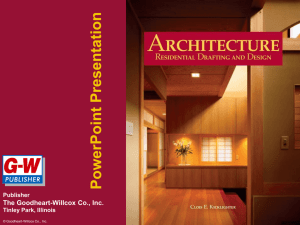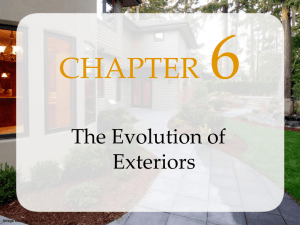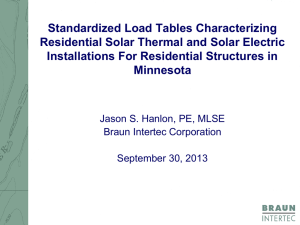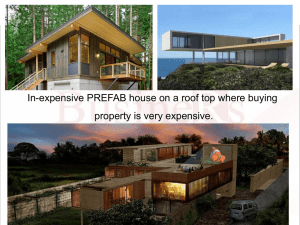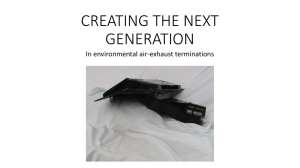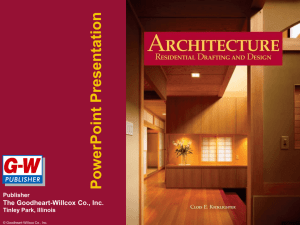Rafters
advertisement
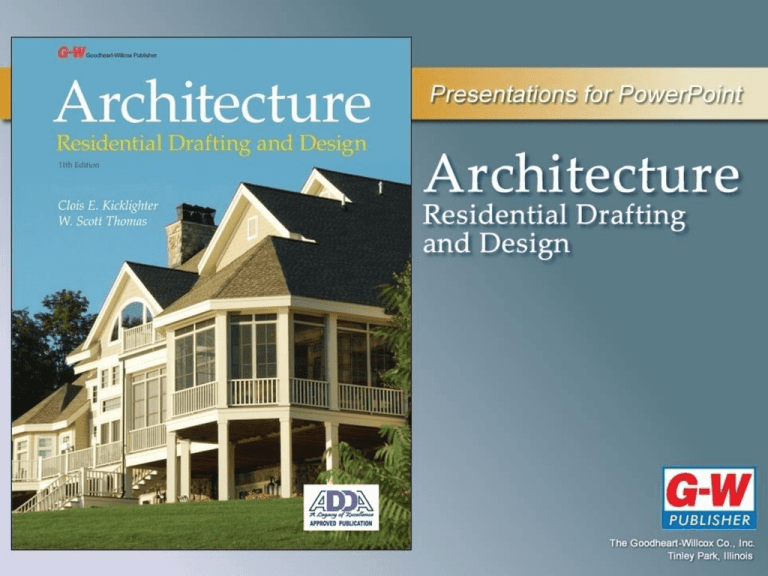
Chapter 16 Roof Designs Objectives • Identify and sketch 12 different types of basic roof designs. • Draw a roof that has a typical roof slope (pitch). • Describe the construction of a typical frame roof. • Explain the importance of proper attic ventilation and roof flashing. • Compare the advantages and disadvantages of new roofing materials. • Explain the purpose of a roof plan. © Goodheart-Willcox Co., Inc. Permission granted to reproduce for educational use only. Types of Roofs • The roof greatly affects the overall appearance of a house • Many standard styles • Style should complement the basic design © Goodheart-Willcox Co., Inc. Permission granted to reproduce for educational use only. Gable Roof • Triangular with a gable at both ends • Easy to build and sheds water well • Applicable to most house designs © Goodheart-Willcox Co., Inc. Permission granted to reproduce for educational use only. Winged Gable Roof • Attractive design feature • Gable roof, extended at the peak • Requires lookout rafters © Goodheart-Willcox Co., Inc. Permission granted to reproduce for educational use only. Hip Roof • Sloped roof section or hip at ends • Slightly more difficult to build than gable roof • Does not provide for ventilation as well as others © Goodheart-Willcox Co., Inc. Permission granted to reproduce for educational use only. Dutch Hip Roof • Hip roof with a small gable at either end • Steeper gables than hips • Gables can be used for ventilation © Goodheart-Willcox Co., Inc. Permission granted to reproduce for educational use only. Flat Roof • Most economical to build • Requires “built-up” or membrane roof covering • Popular in warm climates © Goodheart-Willcox Co., Inc. Permission granted to reproduce for educational use only. Shed Roof • More pitch than flat roof • Used for additions or with other roof styles • Less than 3:12 pitch requires a built-up roof © Goodheart-Willcox Co., Inc. Permission granted to reproduce for educational use only. Gambrel Roof • Also known as “barn roof” • Two different slopes • Provides additional headroom © Goodheart-Willcox Co., Inc. Permission granted to reproduce for educational use only. Mansard Roof • French design • Provides additional living space • Difficult to build © Goodheart-Willcox Co., Inc. Permission granted to reproduce for educational use only. A-Frame Roof • Provides roof and walls for structure • Pitch allows for smaller second floor • Popular for cottages, homes, churches © Goodheart-Willcox Co., Inc. Permission granted to reproduce for educational use only. Butterfly, Folded Plate, and Curved Panel Roofs • Limited residential construction • Used in commercial construction • Can cause drainage problems © Goodheart-Willcox Co., Inc. Permission granted to reproduce for educational use only. Contemporary Roof Types • Warped roof: Limitless in design – Common shape is hyperbolic paraboloid – Made from concrete, plywood, or plastic – Expensive to build • Free-form roof: Freedom with design – Any shape can be formed with fabric and frame – Strong and weather resistant – Limited residential use © Goodheart-Willcox Co., Inc. Permission granted to reproduce for educational use only. Green Architecture • Living Roofs: Covered with soil, capable of growing plants • Benefits: – – – – – Used for growing food Provides excellent insulation Reduces storm water run-off Creates habitat for wildlife May lower air temperatures in large cities © Goodheart-Willcox Co., Inc. Permission granted to reproduce for educational use only. Traditional Frame Roof Construction • Before designing a roof: – Consider the features of traditional frame roof construction – Understand the features impact on the design © Goodheart-Willcox Co., Inc. Permission granted to reproduce for educational use only. Rafters • Rafter: Structural element of the roof that supports the sheathing – Common rafters lay perpendicular to wall plate – Rafters extend from roof’s ridge to plate or beyond – Several types © Goodheart-Willcox Co., Inc. Permission granted to reproduce for educational use only. Rafters © Goodheart-Willcox Co., Inc. Permission granted to reproduce for educational use only. Rafters • Rafters are cut to proper lengths by locating ridge cut, seat cut, plumb cut, and tail cut © Goodheart-Willcox Co., Inc. Permission granted to reproduce for educational use only. Rafters • Layout of rafter cuts are determined by: – Roof slope (roof pitch) – Clear span • Additional factors: – Rise – Run © Goodheart-Willcox Co., Inc. Permission granted to reproduce for educational use only. Rafters © Goodheart-Willcox Co., Inc. Permission granted to reproduce for educational use only. Rafters • Roof slope (roof pitch) is slant of roof • Shown on drawing as: – Slope ratio diagram – Fractional pitch © Goodheart-Willcox Co., Inc. Permission granted to reproduce for educational use only. Rafters • Slope diagram – Indicated by triangle – Shows ratio between rise and run of roof – Run is always expressed as 12 units • Fractional pitch is rise/clear span – Pitch = Rise/Clear Span © Goodheart-Willcox Co., Inc. Permission granted to reproduce for educational use only. Rafters • Rafter sizes depend on: – Spanned distance – Rafter spacing – Supported weight © Goodheart-Willcox Co., Inc. Permission granted to reproduce for educational use only. Rafters • Rafters may serve as ceiling joists on low-sloped roofs © Goodheart-Willcox Co., Inc. Permission granted to reproduce for educational use only. Cornice • Cornice: Roof’s overhang at the eave line that forms connection between roof and side walls • Three types used in residential construction: – Open cornice – Box cornice – Close cornice © Goodheart-Willcox Co., Inc. Permission granted to reproduce for educational use only. Open Cornice • Used with exposed-beam construction, contemporary, or rustic designs • Rafter ends: – Exposed – Tapered or curved © Goodheart-Willcox Co., Inc. Permission granted to reproduce for educational use only. Box Cornice • Space between the ends of projecting rafters and wall is enclosed with a soffit board • Three basic types: – Narrow box – Wide box with lookouts – Wide box without lookouts © Goodheart-Willcox Co., Inc. Permission granted to reproduce for educational use only. Wide Box Cornice With Lookouts © Goodheart-Willcox Co., Inc. Permission granted to reproduce for educational use only. Close Cornice • Rafter does not project beyond wall • Roof is terminated by frieze board and molding © Goodheart-Willcox Co., Inc. Permission granted to reproduce for educational use only. Rake or Gable End • Gable end (rake): Extension of gable roof beyond exterior walls of house – Proportions should be similar to cornice – Special framing is used for wide overhang – Close rake is least expensive to build © Goodheart-Willcox Co., Inc. Permission granted to reproduce for educational use only. Rake or Gable End • Framing for gable end with wide overhang © Goodheart-Willcox Co., Inc. Permission granted to reproduce for educational use only. Roof Trusses • Roof truss – Assembly of members that form rigid framework that supports roof • Information needed to purchase a truss: – – – – © Goodheart-Willcox Co., Inc. Roof span Roof pitch Truss spacing Roof load Permission granted to reproduce for educational use only. Roof Trusses • Adequate roof load is 40 pounds per sq. ft. • Lightweight wood trusses can span distances of 20' to 32' • Typical residential trusses are 2 4 or 2 6 lumber • Gussets fasten members of wood truss together © Goodheart-Willcox Co., Inc. Permission granted to reproduce for educational use only. Roof Trusses • Prefabricated trusses – Less expensive than conventional framing – Available in standard widths and pitches • Common wood trusses: – W-type truss – King-post or K-post truss – Scissors truss © Goodheart-Willcox Co., Inc. Permission granted to reproduce for educational use only. W-Type Truss © Goodheart-Willcox Co., Inc. Permission granted to reproduce for educational use only. K-Post Truss © Goodheart-Willcox Co., Inc. Permission granted to reproduce for educational use only. Scissors Truss • Scissors truss © Goodheart-Willcox Co., Inc. Permission granted to reproduce for educational use only. Raised Heel Truss • When bottom chord of truss extends beyond exterior wall • Provides space for additional insulation © Goodheart-Willcox Co., Inc. Permission granted to reproduce for educational use only. Ventilation • Attic ventilation is a necessity – Reduces moisture condensation under sheathing – Helps cool house interior • Screened openings or ventilators provide attic ventilation – Ventilator openings should be at least 1/300th of ceiling area © Goodheart-Willcox Co., Inc. Permission granted to reproduce for educational use only. Ventilation • Types of ventilators – Gable ends and underside of overhang – Ridge and soffit ventilator © Goodheart-Willcox Co., Inc. Permission granted to reproduce for educational use only. Flashing • Flashing repels water from areas of potential leakage – Used where roof contacts a wall, chimney, roof valley, or at any roof penetration • Placement is beneath surface material per specifications © Goodheart-Willcox Co., Inc. Permission granted to reproduce for educational use only. Flashing • May be weather-resistant metal – Aluminum, copper, galvanized sheet metal • Roof valley flashing can be metal or two layers of 90# roll-type roofing • Metal drip edge flashing – Prevents water from entering behind shingles – Protects fascia and rake boards © Goodheart-Willcox Co., Inc. Permission granted to reproduce for educational use only. Chimney Flashing • Composed of shingle flashing and counterflashing © Goodheart-Willcox Co., Inc. Permission granted to reproduce for educational use only. Gutters and Downspouts • Gutter – Collects water from roof and directs it to downspout that diverts it away from house – Prevents water from running directly off eaves and splattering house – Pitched 1" to 1.5" per 20' – Available in several styles and materials © Goodheart-Willcox Co., Inc. Permission granted to reproduce for educational use only. Roof Sheathing and Roofing • Roof sheathing supports roofing material – Generally plywood or other approved panel product – Thickness depends on rafter spacing – 1/2" sheathing-grade plywood is used when rafters are 16"OC © Goodheart-Willcox Co., Inc. Permission granted to reproduce for educational use only. New Roofing Materials • Asphalt laminate shingles • Metal roofing © Goodheart-Willcox Co., Inc. Permission granted to reproduce for educational use only. Asphalt Laminate Shingles • Thicker, heavier, and more wind resistant than traditional asphalt shingles • Appear three-dimensional © Goodheart-Willcox Co., Inc. Permission granted to reproduce for educational use only. Roofing Materials • Metal roofing: – Gaining wider acceptance for residential construction – Resists high winds – Simulates other roofing materials © Goodheart-Willcox Co., Inc. Permission granted to reproduce for educational use only. Roof Plan • Roof plan—Top view plan that shows information needed to construct roof – – – – Shape Roof pitch Size and location of framing Size and location of roof vents © Goodheart-Willcox Co., Inc. Permission granted to reproduce for educational use only. Roof Plan • Roof framing plan shows: – – – – Exterior house walls Exterior roof lines Size and location of all roof framing members Any additional information needed for roof construction © Goodheart-Willcox Co., Inc. Permission granted to reproduce for educational use only. Employability • Computer ethics – Unethical to use computer for personal activities without permission – Unethical to access confidential information, download copyrighted material, or harass others – Many organizations monitor computer users © Goodheart-Willcox Co., Inc. Permission granted to reproduce for educational use only.
